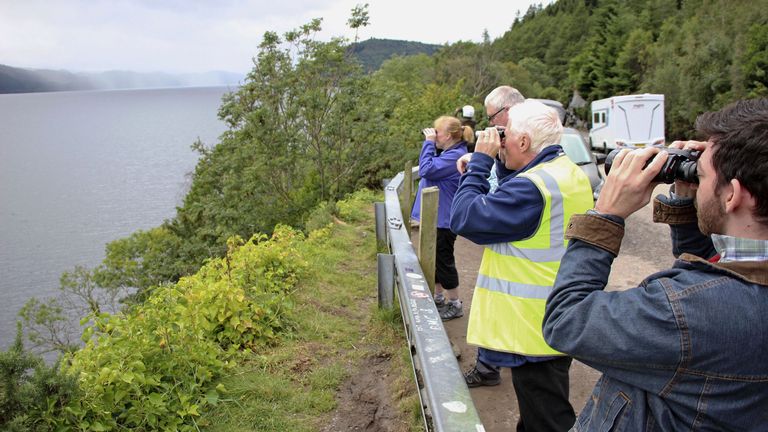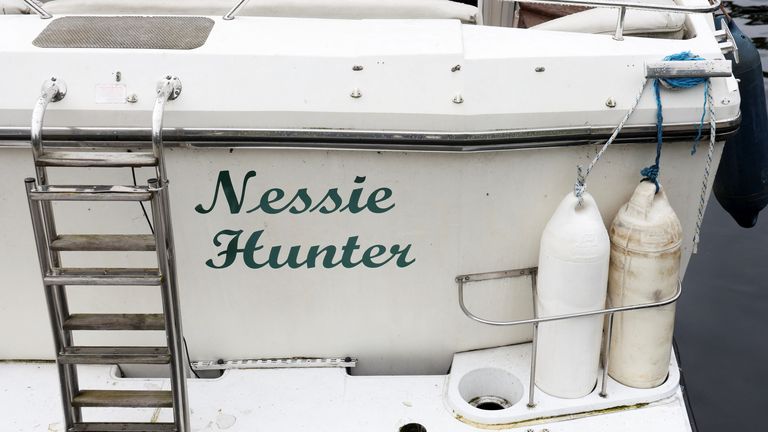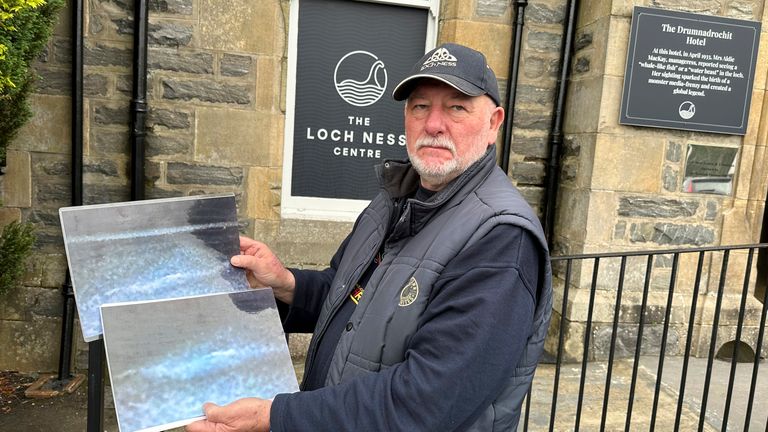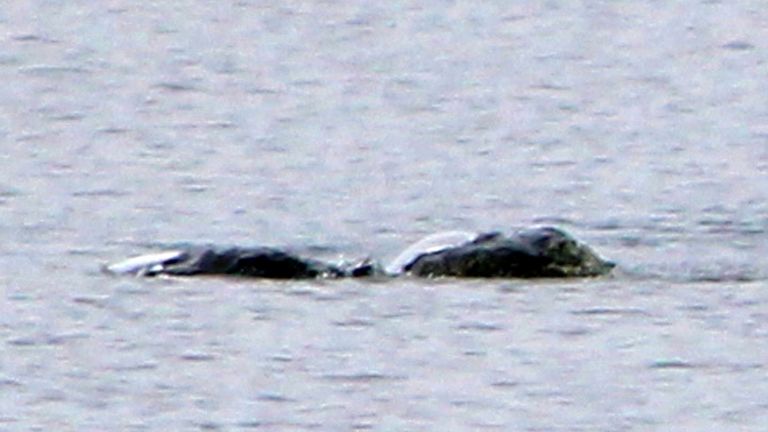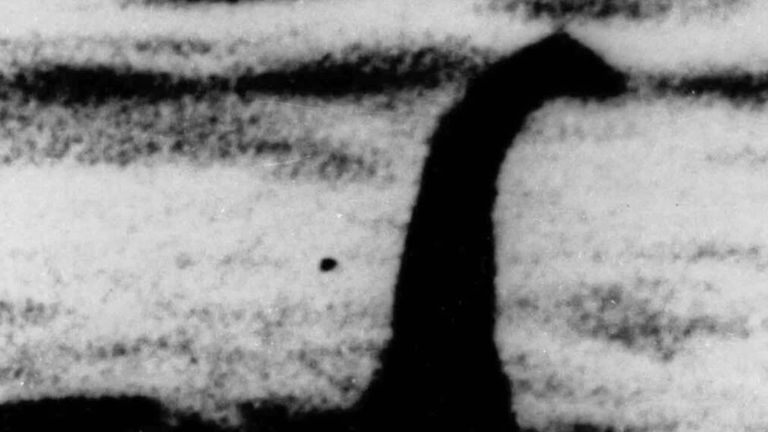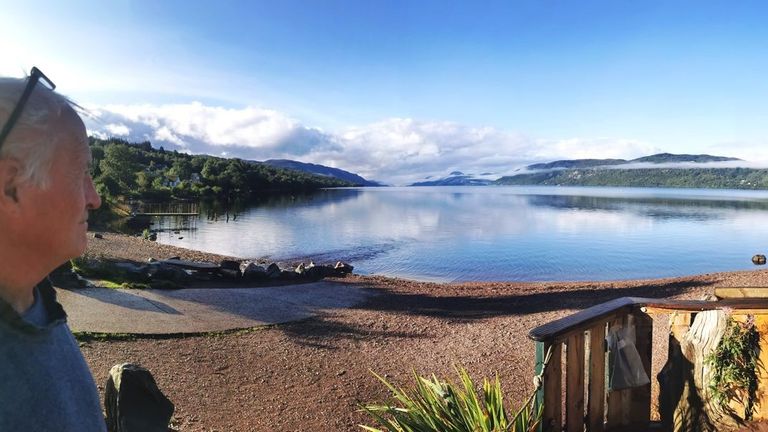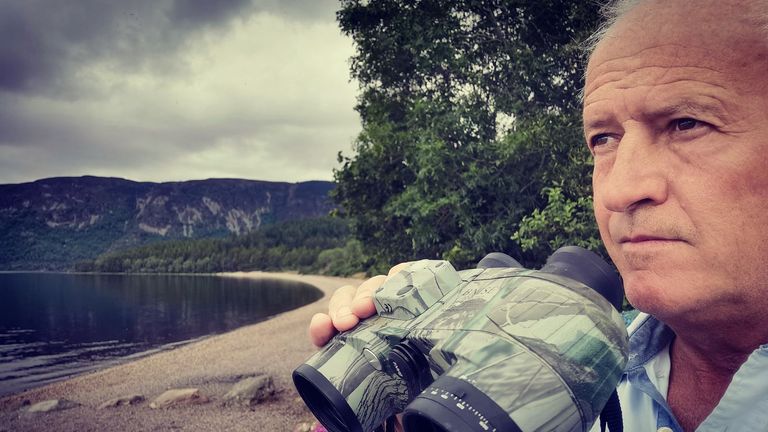The Loch Ness monster and the story behind the mysterious water beast theories - 90 years since first photo
With 1,155 official sightings and counting, Sky News speaks to various figures involved in the hunt for Nessie - including the scientist who wouldn't rule it out...
Saturday 18 November 2023 06:13, UK
On 12 November 1933, a man named Hugh Gray may well have started the orginal viral trend when he snapped the first known photograph of a creature lurking in Loch Ness.
Or, naysayers would argue, an unidentifiable object floating in Scotland's famous deep waters.
Either way, the image caused a ripple effect that's still being felt to this day, with people across the world visiting Loch Ness in the hope of getting a photo of "The Loch Ness monster" themselves.
But it hasn't just been casual visitors.
Teams of investigators, underwater photographers and search teams have tried to find conclusive evidence of the infamous "water beast", also known as Nessie.
In fact, the biggest search of the loch in 50 years took place over two days in August, with around 100 volunteers looking for the mysterious creature each day. The beast remained hidden throughout.
So are there genuine believers in a giant aquatic monster in 2023, or is Loch Ness now a mere tourist destination for travellers who want to say they've been?
Where it all began
The first high-profile report of a Nessie sighting was published by The Inverness Courier in 1933, after a local hotel manageress claimed she spotted a "water beast" in the loch.
Aldie Mackay described the moment she saw a "fearsome-looking monster" as she and her husband were driving near the water.
Mrs Mackay's statement put Nessie on the map, but reported sightings at Loch Ness go all the way back to 565AD, according to historian, Professor Henry H Bauer.
The Inverness Courier's report, along with Hugh Gray's photo taken later that year, sparked a global and long-lasting fascination with finding the elusive monster.
Where we are now
We are now at least 1,155 official sightings in - and counting.
There have been nine logged sightings this year, with the last one coming on 7 October from a man on a coach that was passing the loch.
And much like with most jobs and hobbies, monster hunting has moved into the 21st century, with an Inverness and Loch Ness tourist site allowing you to investigate from the comfort of your home, via 24/7 CCTV across the loch.
Numerous theories have been put forward over the years, including that the creature may be a prehistoric marine reptile, a swimming circus elephant (yes, really) or, most recently, a giant eel.
'Real or not, it's a win-win'
Willie Cameron, known widely by locals as "Mr Loch Ness", is the founder of Loch Ness Marketing, a company providing services to film and media crews on location at the loch.
He estimates that this year alone, around two million tourists from around the world have visited Loch Ness, "probably generating in excess of £55m to the economy".
"Interest globally has never, ever been higher" in the monster, he adds.
When asked if he thinks there's a scenario where the search for Nessie stops, the 72-year-old says: "Even if artificial intelligence came out tomorrow with 100 reasons why there is nothing in Loch Ness, trust me, 50% of people would believe that there is something in Loch Ness.
"We're in a win-win situation. If it's there, it's there, if it's not, it's not going to make one iota of a difference. People love a mystery."
The entrepreneur, who says his father had a potential sighting in 1965, told Sky News he also saw something "most unusual" in the loch in August 2016.
He adds that he knows plenty of people who say they've seen the monster, but would never speak to the media or officially log their sightings "for fear of being ridiculed".
One cannot be blamed for feeling sceptical; the single certainty when it comes to Nessie is that there has never been any conclusive evidence she exists.
In fact, the most famous depiction of the beast, first published in 1934, was revealed to be a hoax in the 1990s.
It begs the question: if we can't trust a photo from the 1930s, how are we supposed to have faith in the age of Photoshop and AI modification?
Nurse by day, monster-sighting registrar by night
That's where sightings gatekeeper Paige Daley comes in.
Ms Daley recently took over the official Loch Ness monster sightings register from her father, Gary Campbell, who also started the Loch Ness Monster Fan Club in 1996 after he had a potential Nessie sighting himself.
The site logs all known sightings dating back to early medieval England.
"I'm a nurse by day," Ms Daley tells Sky News, "and then I spend the rest of my time looking into the Loch Ness monster and mystery of Loch Ness, trying to work out what's going on.
"We receive hundreds of sightings through the year of unexplained things in Loch Ness. But it does go through a verification process.
"We've got to weed out what could be an actual occurrence in Loch Ness, what could be a hoax, and what does actually come down to being something unexplained that could be the monster."
Ms Daley says she carries out a list of tasks before formally logging a sighting:
- Assessing the background and foreground of images to make sure it's Loch Ness and not a random body of water
- Ruling out things that could be naturally occurring in Loch Ness. She says people sometimes send photos of what can be dismissed as ducks or seals, wakes from boats, or even scuba divers making bubbles in the water
- With some sightings, contacting academics who have degrees in marine biology, to get their take.
She may also log sightings where no photo was taken - but anyone contacting her should expect an interrogation about what they saw.
"I think there is a heavy weighting towards people feeling that it is a true touristy gimmick," Ms Daley admits.
"However, I feel that every person who does go there deep inside them believes that they truly could capture a glimpse of the Loch Ness monster.
"We've had over a thousand sightings of this unexplained creature at Loch Ness, so it may be an easy copout for people to say it's a tourist attraction instead of looking at the evidence suggesting that there is something unexplained in Loch Ness.
"It's amazing to see that 90 years ago, the world got the first glimpse of the Loch Ness Monster and that 90 years later, we're still getting submissions."
The scientist who didn't quite rule it out
Professor Neil Gemmell, a scientist at the University of Otago in New Zealand, led a major international monster hunt at Loch Ness in June 2018.
He took 250 water samples from various depths, hoping to identify the tiny fragments of DNA that skin, feathers, scales and urine leave behind and compared it with known species.
It was from this study's findings that the giant eel theory was born.
"There is a very significant amount of eel DNA. Eels are very plentiful in Loch Ness," Prof Gemmell said when sharing the findings.
"Our data doesn't reveal their size, but the sheer quantity of the material says that we can't discount the possibility that there may be giant eels in Loch Ness."
He added: "For the people who still want to believe in monsters, there is still a lot of uncertainty in our work."
The professor wanted to search the lake to showcase the science of eDNA to the world.
He floated the idea on social media in 2016, expecting little interest. But a Scottish newspaper picked it up and "all hell broke loose", Prof Gemmell told Sky News.
"I was getting phone calls and requests for interviews," he said.
"Suddenly I was the New Zealander who was going to go hunting this monster using DNA technologies… I hadn't actually done a damn thing yet. I'd just opened my mouth and said we could do it.
"I've never had that level of interest in any of my other science. My kids, who were about five and eight at the time, and all their friends were really excited by it.
"So I sat there and thought to myself, 'You know, they don't get excited about my other work. Maybe, I could take a few people - and myself - on a bit of an adventure'."
He says he still receives emails about the monster to this day. Some of them are children's drawings of Nessie, which the professor says are "always fun".
His personal favourite piece of mail, he adds, was a five-page letter, "beautifully embossed" by someone claiming to be from a Scottish university, detailing a wild conspiracy involving the Official Secrets Act, the British military and the revelation that the Loch Ness monster was in fact a camel in a wetsuit.
Read more:
Man takes venomous snake home to show children, ends up in hospital
We thought starfish didn't have heads - we were wrong
His interactions with Loch Ness enthusiasts has led him to conclude that "there are people who genuinely, fervently believe" in the monster, "and there's others who exploit it".
The man who gave up his job, girlfriend and house for Nessie
There are those who believe, and those who believe.
Steve Feltham holds the Guinness World Record for "the longest continuous vigil for the Loch Ness Monster", with 32 years under his belt - and counting.
"I very much arrived here with a mission statement to prove to the world that this mystery warrants investigation," he tells Sky News.
"But now, I'm doing it primarily for the satisfaction of my lifelong fascination, and anything I discover along the way that then seeps into the public domain is a bonus. It's no longer my mission to convince the world."
Mr Feltham speaks to us from his once-mobile library van - which he has dubbed "the research van" - now permanently located on Dores Beach, Loch Ness.
It's been his home since he left his job as a burglar alarm installer, broke up with his long-term partner and sold his house in Dorset to pursue full-time monster hunting in 1991 - a dream born from visiting the loch with his parents when he was seven.
The 60-year-old has now spent more than half of his life watching over the Scottish waters, living off profits from handmaking and selling Nessie models to tourists.
In that time, he's only had one near-sighting; when he saw something go through the water "like a torpedo", with water spraying off the back of the object.
That was more than 30 years ago.
Asked if he's still confident of spotting the infamous water beast, he says: "Well believe I'm in the right place to find it. Definitely."
Mr Feltham suspects Nessie is most likely to be a Wels catfish - one of the world's largest freshwater fish - though he admits "we don't have enough information yet to give a definitive answer".
There are no guarantees in the monster-hunting trade. If he spends the rest of his life on Dores Beach and never finds Nessie, would he still stand by his life decisions?
"Good God, yes," he assures us. "I spent 10 years in the rat race and at the age of 28 decided that it wasn't for me and that there were other things I would rather do with my life.
"Following my passion, my dream, and being fully involved in a wonderful mystery on all sorts of levels… it's the place I'm meant to be."
A monster hunter's legacy
Asked about what he wants to be remembered for, Mr Feltham says: "I want other people to remember that they don't have to live a mundane life, doing something they really don't want to do.
"If they've got a dream to do something else - to be a painter or be a singer, or go live in America or whatever their passion is - I'm here to say it doesn't matter how odd that is. I mean, it's quite an off-the-wall pursuit that I've chosen.
"But whatever they do," he warns, "I certainly don't want those people to come and sit in a camper van and try to solve this mystery! I want them to go on their own adventure."


